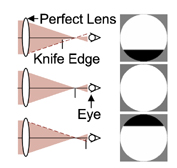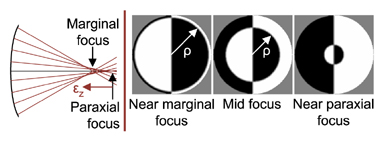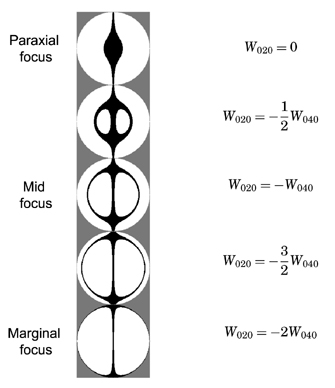Optipedia • SPIE Press books opened for your reference.
Foucault (Knife-Edge) Test
Excerpt from Field Guide to Interferometric Optical Testing

This test is one of the oldest and most common tests for determining longitudinal and transverse aberrations. A knife edge is placed near the focus and passed through the image of a point or slit source. The shadow, observed by the eye (shown) or on a screen, gives information about the aberration content. A perfect lens will have one image point that darkens almost instantaneously when the knife edge passes though the image. These shadow patterns are based off of geometrical analysis; diffraction will blur out the edges.

Spherical aberration can be determined using this test. The boundary of the geometrical shadow with normalized pupil coordinates and the knife edge on the optical axis is a vertical line (y = 0) and a circle of radius ρ, where εz is the axial distance from paraxial focus, R is the radius of curvature of the wavefront, and rp is the pupil radius. By measuring ρ as a function of εz,
W040 can be determined.

The advantage of the knife-edge test is its simplicity. No accessory optics are required, the whole surface is measured at once, and it is a sensitive test. The disadvantage is that it is sensitive to slopes rather than heights and only measures in a single direction with a single orientation of the knife edge.
The knife edge is most often used to measure the zonal focus of different parts of an optical surface so the optician can determine the high and low surfaces parts.
An improved alternative to the knife edge is to use a phase delay knife edge, where both sides transmit with a phase difference between the two halves of 180°. The diffraction pattern is then symmetric, and the boundary centers are easier to determine.
Wire Test
The wire test is the same as the Foucault test except the knife edge is replaced with a wire, or inversely, a slit. The wire can simply be a strand of hair. The wire test is inferior for qualitative data but superior for obtaining quantitative data since the wire produces a symmetric shadow. It is easier to determine the center of the shadow.

E. P. Goodwin and J. C. Wyant, Field Guide to Interferometric Optical Testing, SPIE Press, Bellingham, WA (2006).
View SPIE terms of use.
Non-Member: $42.00

